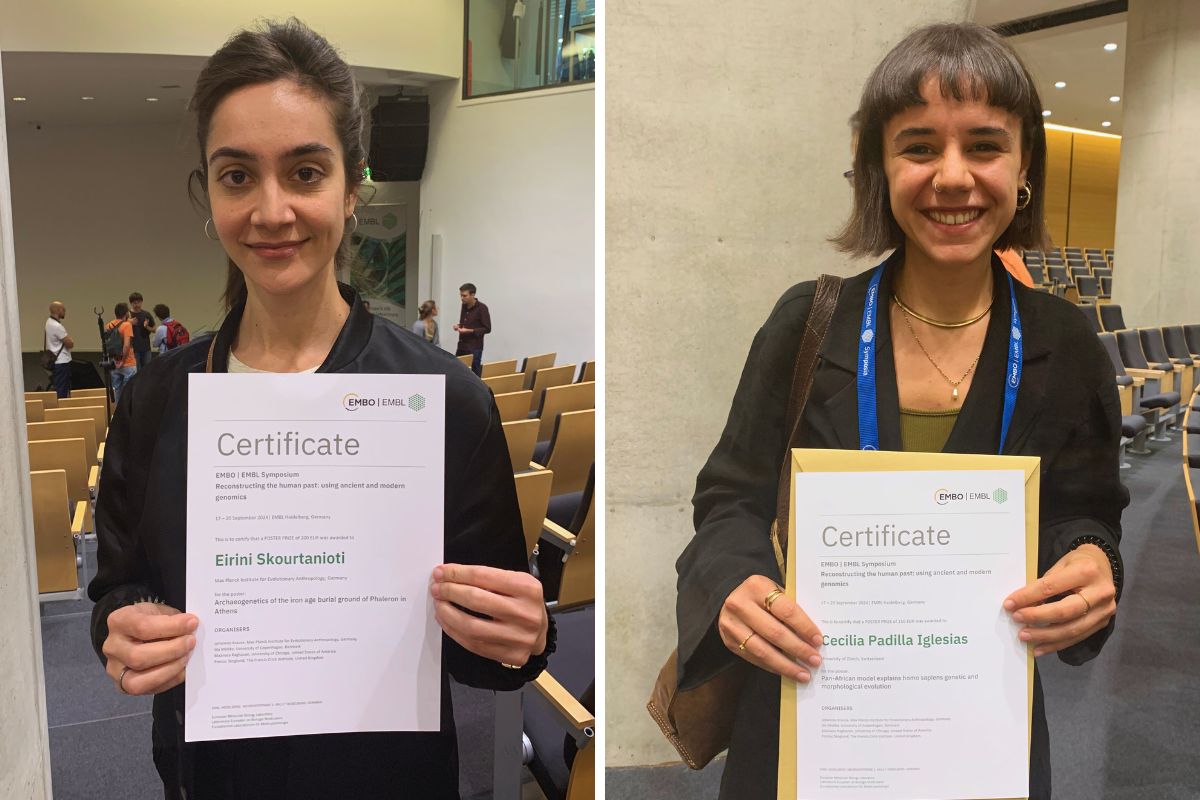Best poster prizes at ‘Reconstructing the human past: using ancient and modern genomics’
The EMBO | EMBL Symposium ‘Reconstructing the human past: using ancient and modern genomics‘ took place last month at EMBL Heidelberg. It is a multi-disciplinary meeting on studies of the human past using archaeogenomic methods to reconstruct the landscape of human genetic variation over time. Among the highlights, we had the Nobel laureate Svante Pääbo from Max Planck Institute for Evolutionary Anthropology joining us as a keynote speaker!
For this year’s edition of this conference, we had 173 people attending on-site and 59 participants attending remotely. There were 8 fellowships provided by the EMBL Corporate Partnership Programme and EMBO. With the total of 83 posters to view, we held two poster sessions during which the presenters could discuss their research — their work was then voted for by all participants. There were three poster prizes awarded during the meeting. We are pleased to share with you all of the winners’ abstracts.
1st place:
Archaeogenetics of the iron age burial ground of Phaleron in Athens
Presenter: Eirini Skourtanioti
Authors: Eirini Skourtanioti, Anthi Tiliakou, Johannes Krause, Alissa Mittnik, Raffaela Bianco, Angela Mötsch, Eleni Anna Prevedorou, Stella Chryssoulaki, Panagiotis Karkanas, Jane Buikstra, Johannes Krause, Philipp Stockhammer

Max Planck Institute for Evolutionary Anthropology, Germany
Abstract:
Located on the southern coast of Attica in Greece, Phaleron served as one of the principal ports of Athens in ancient times. Excavations have revealed a burial ground comprising approximately 2,000 burials, spanning the late 8th to the 4th century BCE. This extensive cemetery offers insights into the burial practices, social structures and political changes inAthens at a pivotal moment for the rise of democracy and the associated socialand politicalconflicts. With a wide variety of burial types from elaborate funerary monuments, to simple pit and jar burials, and ‘deviant’ burials of violent deaths, the site provides a unique opportunity to study the transition from the Geometric to the Archaic and Classical period in Athens through the study of the health, diet, lifestyles and genetics of the ancient population.
The exceptional data recovered from Phaleron has now been enlarged by new ancient DNA analysis. By applying state of the art, highly specific enrichment protocols, we have generated genome wide data from more than 100 individuals sampled from diverse burial contexts within a sector of the burial ground. Our analyses reveal a unprecedented rate of individuals with ‘non local’ ancestry showing no association with distinctive burial type features. In contrast to earlier Bronze Age Aegean sites, where ancestry outliers reflect population migration from Anatolia and later the Eurasian steppe, in Phaleron, the non local ancestry predominantly belongs to the broader Central and Eastern Mediterranean gene pool, but also Central Asia and Europe. In addition, when analyzing individuals with ancestry typical in the Aegean, we find genetic continuity since the Late Bronze Age suggesting that the transition still referred to sometimes as ‘Greek Dark Ages’ was not accompanied by major admixture events into the Aegean. Finally, to estimate relatedness, we employed the method Identical By Descent which indicated that the individuals were distantly and sporadically related, rather than being members of biological families. Combined with the evidence for continuing the practice of consanguineous endogamy although more moderately our analyses suggest that the Phaleron cemetery reflected a large and diverse population as well as local communities of extended families.
Due to the confidentiality of the unpublished data, we cannot share the poster.
2nd place ex aequo:
Reconstructing the genomic history of Eastern Polynesians: insights into phenotypic variation in the Pacific
Presenter: Dang Liu
Authors: Dang Liu, Gaston Rijo de Leon, Maguelonne Roux, Leo Speidel, Iotefa Teiti, Anita Tessier, Vaea Richard, Maïté Aubry, Christine Harmant, Aurélie Bisiaux, Zhi Li, Anthony Jaquaniello, Phillip Endicott, Annie Forster, Adrian Hill, Alexander Ioannidis, Andres Moreno, Alexander Mentzer, Van Mai Cao Lormeau, Etienne Patin, Lluis Quintana Murci

Institut Pasteur, France
Abstract:
Reconstructing the genomic history of human populations provides insights into their demographic past and the evolutionary forces shaping phenotypic variation. Polynesians, a large ethno linguistic group living on islands between Aotearoa, Hawaiʻi, and Rapa Nui, as well as in regions outside the Polynesian triangle (i.e., the ‘Outliers’), are thought to have experienced strong founder events and extensive admixture. These populations present some of the highest prevalences of metabolic disorders worldwide, raising questions about the role of natural selection and genetic drift in contributing to this heightened risk. Although a few high frequency variants associated with obesity and diabetes have been detected in Polynesians, the underlying evolutionary mechanisms remain elusive.
Here, we generated whole genome sequences (WGS) from 1,881 individuals across 24 islands from Western and Eastern Polynesia, and the Outliers. We first focused on inferring their demographic past, by analyzing 30× WGS for a subset of 123 individuals, which were combined with a global genomic dataset. We estimated that all Polynesians descend from a major admixture event between East Asian and Papuan related groups dated to ~2,100 years ago. Genealogy based methods supported the simultaneous radiation of Polynesian groups, followed by strong population bottlenecks in Eastern and Outlier groups. Additionally, we estimated another radiation event within Western and Eastern Polynesia over the last ~1,000 years, in line with archaeological evidence.
Next, we explored the genetic architecture of metabolic traits by analyzing 10× WGS from 1,770 Eastern Polynesians and collecting extensive phenotypic data. Our analyses revealed that genetic ancestry was associated with BMI, HbA1c, and lipid traits, after controlling for confounders, and identified novel variants associated with metabolic traits, including some private to Pacific groups. Notably, we found no evidence for strong selective sweeps on these variants, suggesting a predominant role of genetic drift in explaining the higher genetic risk for metabolic disorders in the region. These results highlight how reconstructing the genetic history of understudied populations can increase our understanding of the evolutionary sources of phenotypic variation.
Pan African model explains homo sapiens genetic and morphological evolution
Presenter: Cecilia Padilla Iglesias
Authors: Cecilia Padilla Iglesias, Zhe Xue, Michela Leonardi, Johanna Paijmans, Anahit Hovhannisyan, Margherita Colucci, Lucio Vinicius, Andrea Migliano, Andrea Manica

University of Zürich, Switzerland
Abstract:
Emerging archaeological, paleoanthropological and genetic evidence have challenged the traditional view that Homo sapiens originated from a single African region. Instead, it has been proposed that our species emerged and diversified within numerous, geographically distinct populations in Africa that became in contact at different points in time, exchanging genes and culture. Whilst analyses of contemporary and ancient genomes from African hunter gatherer groups support deep divergence times between them, coupled with intermittent episodes of gene flow, these events are lacking a geographic and, perhaps more importantly, the climatic context in which they took place. Our study employs a Climate Informed Spatial Genetic Modelling (CISGeM) framework, integrating Species Distribution Models built from African hunter gatherer archaeological assemblages and paleoclimatic reconstructions with data from all available contemporary and ancient African hunter gatherer genomes. This allows formally assessing whether inferred geographic range changes from SDMs, inter regional migrations and demographic fluctuations can be reconciled with genetics. We utilise Approximate Bayesian Computation to determine which demographic parameters (migration rates, admixture dates, growth rates…) are most supported. Then, using craniometric data from 45 fossils from the Middle Pleistocene until the present, we verify that our CISGeM framework is not only able to reconstruct patterns of H. sapiens genetic evolution, but also morphological diversity over time. Our findings suggest that temporal patterns of African genetic and morphological diversity are attributable to climatic influences on population dynamics, and do not require the necessity for hypothesized introgression from “ghost” populations. We pinpoint key environmental factors promoting and hindering gene flow between African regions and outline the historical geographical range of ancient hunter gatherer populations. This research highlights the value of incorporating genomic data into spatially explicit models to elucidate the complex processes shaping human evolutionary trajectories.
Due to the confidentiality of the unpublished data, we cannot share the poster.

The EMBO | EMBL Symposium ‘Reconstructing the human past: using ancient and modern genomics’ took place from 17 – 20 September 2024 at EMBL Heidelberg and virtually.